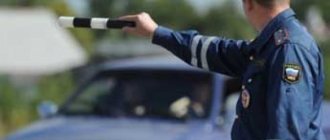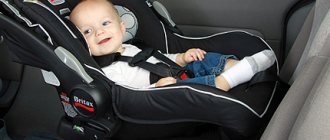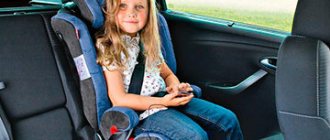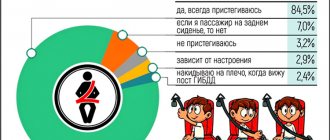A frameless child seat is more affordable, but its use is controversial. Whether it’s possible or not, let’s try to figure it out in this article.
Dear readers! The article talks about typical ways to resolve legal issues, but each case is individual. If you want to find out how to solve your particular problem , contact a consultant:
+7 (499) 938-81-90 (Moscow)
+7 (812) 467-32-77 (Saint Petersburg)
8 (800) 301-79-36 (Regions)
APPLICATIONS AND CALLS ARE ACCEPTED 24/7 and 7 days a week.
It's fast and FREE !
Concept
Regarding a child's frameless car seat, it should be clarified that this is a restraint device that is shaped like a chair, but does not have a rigid frame.
It is attached to the standard car seat using belts.
Available:
- headrest;
- soft back;
- and a seat.
There are five-point harnesses in front designed to secure a small passenger. A standard seat belt is also used - it is pulled through the front of the car seat, fastening the child.
Legislation
To find out whether a frameless child car seat is allowed by the traffic police, you need to refer to the legislation.
- According to clause 22.9 of the traffic rules , for small passengers under 12 years old, it is required to install restraint devices selected for weight and height.
- Frameless car seats are those that are confirmed by GOST 41.44-2005 (approved by order of Rostechregulirovanie No. 318 of December 20, 2005 ).
If there is a child in the car, the traffic police inspector will check for the presence of a child restraint when stopping the car. He also has the right to check whether the seat is secured with seat belts and whether the weight of the young passenger is suitable.
If violations are detected, a fine of RUB 3,000 will be issued. in accordance with Art. 12.23 Code of Administrative Offenses of the Russian Federation.
Advantages and disadvantages of frameless car seats, are they allowed according to traffic rules 2021?
No matter how you search, there is no direct and obvious answer in legal acts about the possibility of using frameless children's products. But there are general requirements for driving in a car with children.
According to clause 22.9 of the traffic rules, transportation of children:
- at the age of 0-6 years is allowed only if a child restraint system (CRS) is installed in the car, which corresponds to the height/weight of the minor - and here we are not talking only about a frameless car seat;
- at the age of 7-11 years, it is allowed if there is a CRS corresponding to the height/weight or when using seat belts in the rear seat, and in the front seat - only if using a CRS corresponding to the height/weight. That is, a child over 7 years old does not have to be seated in the back seat - they can also be fastened with seat belts.
Thus, the legislator calls any device for seating children as “restraint devices.” Height/weight requirements are usually specified in the instruction manual. As a rule, cradles are used for infants, and for older children, seats and other devices are used.
But is it possible to transport children in frameless chairs and at what age? As you can see, there is no information in the traffic regulations about which child seats to install in the car. The only caveat is that any CRS installed in the car must comply with the Technical Regulations CU R RS 018/2011 “On the safety of wheeled vehicles.”
Installation
Is a frameless car seat allowed for use when transporting small passengers? Yes, but only if it is installed correctly and securely. And it’s quite easy to do.
How is a frameless car seat attached? To fix it you need:
1. Inside the car, tilt the back of the seat on which the child will ride.
2. Take the two longest belts of the device and stretch them between its back and the seat of the car, starting from the front side and ending with the back.
3. Place two shorter upper straps in the upper part of the backrest.
4. Connect the lower and upper belts using special fasteners, while securely fixing the chair, which should fit well to the seat. Next, the backrest can be given its original position.
5. After this installation, sit the child down. And already on a small passenger, adjust the length of the vertical and side belts. Next, they should be fastened with all available locks, of which, as a rule, there are four. Attachment should occur at the level of the groin area, hips and shoulders.
To further guarantee safety, a standard belt located inside the car can be fixed over this design. It is threaded through the pocket that is in the car seat and attached to the lock. However, when installing a standard belt, you must ensure that it does not interfere with the child and is not at the level of his neck or abdomen.
Do frameless frames comply with the Technical Regulations?
But this question cannot be answered unambiguously. The fact is that, according to clause 35 of the List of requirements for types of vehicle components, restraint devices are recognized as meeting the requirements of the Technical Regulations provided they comply with UNECE Rule No. 44-04, and in Russia, as of 2021, GOST R 41.44-05 is recognized as such. .
But in its text there is also not a word whether frameless child seats can be used in a car. But this, again, does not mean that transporting a child in them is illegal! The fact is that most of these CRSs are devices of one-piece construction with a three-point fastening belt. And this design already meets the requirements of GOST R 41.44-05.
You will also be interested in:
- A child in the front seat - at what age can you drive under the new law?
- At what age can a child be transported in a booster seat and at what age can a child be transported without a booster?
- What changes to the traffic rules came into effect in the summer (July) 2021?
Dimensions
Why are frameless car seats attractive to buyers? Reviews from parents who have chosen such protective devices for their children note their compactness.
It is sometimes difficult to fit even two frame structures into the interior of an average small car.
And when an adult passenger needs to sit in the seat instead of a child, the seat will have to be constantly removed in order to be reattached for the child. This will take some time and will wear out the fasteners.
The situation is completely different with a frameless structure. You can attach it once and then simply forget about it. The device is relatively small in size. Its length is 55 cm with a thickness of 4.5 cm and a width of 50 cm.
How do I know if my car seat fits?
But how can you determine whether the specific device you purchased for transporting children meets the requirements of GOST and Technical Regulations? Everything is very simple - when purchasing you will have 2 criteria, and both must be met:
- an approved frameless chair comes with a certificate of conformity, so ask the seller to give you a certified copy just in case,
- The correct car seat is marked in a certain way as complying with the UNECE Regulations.
Just ask the seller for a certificate of conformity issued by Rosstandart. If it indicates that the product complies with TR 018/2011, such a seat can be installed in a car and used when transporting children, since it complies with the Road Traffic Regulations.
As for the labeling, we'll take a look at what it looks like and what it does a little lower.
Certificate verification
The certificate of conformity itself can be checked in the unified Rosstandart database on the official website of RosAccreditation.
To do this, do 3 simple things:
- find the certificate number on the paper that was given to you in the store:
- enter the certificate number in the appropriate field on the website:
- Click on the “find” button.
As a result, you will be given information about the validity of the certificate, although in practice the document is often not found. In any case, a frameless chair can only be used under the following conditions:
- current certificate status,
- not expired document (expiration date in the future).
For long trips
Who else chooses a frameless car seat? Parents often prefer to purchase such a device for securing a small passenger when going on a long trip with their child.
After all, if you sit the baby in a strictly fixed position, then after 3-4 hours he will begin to be capricious and cry. Probably any adult would feel uncomfortable in such a situation. But in a frameless car seat, a child can sit softly and comfortably.
This type of security
Parents can and should demand from a child car seat that it ensures maximum safety for the child in the car. If classic models are able to protect a small passenger even in the event of a serious accident, then frameless models are less reliable in this regard.
A rigid frame - made of metal, plastic or a combination - performs an important function. It provides support to the spine, and in the event of a collision, it partially absorbs the force of the impact. Without fixation on a rigid frame, the spine and internal organs are exposed to much greater impact. In addition, fastening belts stitched with ordinary threads will not withstand the load in the event of an accident, especially if the child is heavy.
Another point: the frameless design does not provide head protection in the event of a side collision. It will also not be possible to quickly free a small passenger from such a restraining device.
Despite the insufficient level of safety, a child seat without a frame is the best option for parents who do not have their own car.
You can take it with you on trips in rented cars, on friends' transport, or in a taxi. After all, you cannot transport a child in a car without a special seat.
What does the device look like?
A frameless car seat for children is a small carpet made of soft material; its design does not include a single rigid part. The fabrics used to make a baby chair must be non-stiff, odorless, breathable and have three layers of spongy material.
RBs are sewn to the base of the car seat to secure the small passenger. This device has a loop at the level of the child’s belt; it is made for a car safety belt. However, it exists on all types of chairs. The car seat straps are very wide, this is an additional detail for the safety of the child.
Manufacturers divide all protective devices for moving children into six classes, each of which is related to how old the child is. However, these car seats are an exception.
Manufacturers combine three age categories at the same time:
- Designed for babies weighing from 9 to 18 kilograms. These are mostly preschoolers.
- For schoolchildren, it is better to buy a device of the second category. It is designed for children whose weight is from 18 to 22 kilograms.
- For children weighing from 22 to 36 kg, you need to buy a large car seat.
This wide range is due to the possibility of different fixation of the shoulder pads and the absence of limiters on both sides. This fact is very important when purchasing a device, because in conventional car seats it is necessary to take into account not only the age of the baby.
It is important that the chair fully suits the height and weight of the child. A baby moved in a regular chair most often feels discomfort, movements are constrained due to the discrepancy between the dimensions of the device and the body.
Crash test
Before launching restraint systems into mass production, manufacturers conduct crash tests. This makes it possible to identify shortcomings and eliminate them, increasing the quality and safety of children's frameless seats.
One of the authoritative organizations conducting such tests is the ADAC car club. on its official website , which anyone can view.
During the tests, several parameters are checked:
- practicality;
- environmental friendliness;
- ergonomics;
- functionality;
- and safety.
At the moment, all models of frameless car seats are inferior to frame models in these parameters. Still, they cope with their tasks, which is confirmed by the fact that such restraint devices have not been officially banned.
Don’t know what the penalty is for transporting a child without a child seat? See the article about this: responsibility for transporting children without a child seat. Do you want to know at what age you can drive without a child seat? Read the details here.
Manufacturers
Nowadays there are many manufacturers on the market, so making a choice is not easy.
The best option is to use products from well-known companies that have proven themselves in the field of child safety.
Fundamental factors when choosing a frameless chair:
- availability of a certificate;
- fastening system;
- size;
- material.
Make sure that the product has the European certificate ECE R44/04. This is confirmation that a crash test was carried out at a speed of 50 km/h in forward motion and at a speed of 30 km/h in reverse.
Examine the certificate label - it should contain information about:
- models;
- type of fastening;
- permissible weight of the child;
- the country where the certification was carried out.
For children under 3 years old, a five-point fastening system is recommended. The Y-shaped mount prevents damage to the child's internal organs and spine in the event of an accident. The rest of the time, the small and mobile passenger remains securely fixed in the recess of the seat.
It is important that the junction of the five belts does not form a “point”, but a high and wide pad made of durable and elastic fabric. This eliminates the risk of injury to the groin area and eliminates possible discomfort while traveling.
The car seat should be made of durable fabric with polymer fibers with spongy soft pads. The material must be environmentally friendly and breathable.
Is a frameless child car seat allowed in the traffic police?
A frameless child seat is more affordable, but its use is controversial. Whether it’s possible or not, let’s try to figure it out in this article.
Concept
Regarding a child's frameless car seat, it should be clarified that this is a restraint device that is shaped like a chair, but does not have a rigid frame.
It is attached to the standard car seat using belts.
Available:
- headrest;
- soft back;
- and a seat.
There are five-point harnesses in front designed to secure a small passenger. A standard seat belt is also used - it is pulled through the front of the car seat, fastening the child.
Legislation
To find out whether a frameless child car seat is allowed by the traffic police, you need to refer to the legislation.
If there is a child in the car, the traffic police inspector will check for the presence of a child restraint when stopping the car. He also has the right to check whether the seat is secured with seat belts and whether the weight of the young passenger is suitable.
If violations are detected, a fine of RUB 3,000 will be issued. in accordance with Art. 12.23 Code of Administrative Offenses of the Russian Federation.
This type of security
Parents can and should demand from a child car seat that it ensures maximum safety for the child in the car. If classic models are able to protect a small passenger even in the event of a serious accident, then frameless models are less reliable in this regard.
A rigid frame - made of metal, plastic or a combination - performs an important function. It provides support to the spine, and in the event of a collision, it partially absorbs the force of the impact.
Without fixation on a rigid frame, the spine and internal organs are exposed to much greater impact.
In addition, fastening belts stitched with ordinary threads will not withstand the load in the event of an accident, especially if the child is heavy.
Another point: the frameless design does not provide head protection in the event of a side collision. It will also not be possible to quickly free a small passenger from such a restraining device.
Despite the insufficient level of safety, a child seat without a frame is the best option for parents who do not have their own car.
You can take it with you on trips in rented cars, on friends' transport, or in a taxi. After all, you cannot transport a child in a car without a special seat.
Is it possible to use a frameless child seat?
Current regulations do not prohibit the use of this type of car seat.
Moreover, its installation is allowed not only in the rear seat, but even in the front seat if there is no front airbag in the car at all or if it is absent in a particular situation.
In this case, the child will not be injured in an accident.
Crash test
Before launching restraint systems into mass production, manufacturers conduct crash tests. This makes it possible to identify shortcomings and eliminate them, increasing the quality and safety of children's frameless seats.
One of the authoritative organizations conducting such tests is the ADAC car club. on its official website , which anyone can view.
During the tests, several parameters are checked:
- practicality;
- environmental friendliness;
- ergonomics;
- functionality;
- and safety.
At the moment, all models of frameless car seats are inferior to frame models in these parameters. Still, they cope with their tasks, which is confirmed by the fact that such restraint devices have not been officially banned.
Do you want to know at what age you can drive without a child seat? Read the details here.
Manufacturers
Nowadays there are many manufacturers on the market, so making a choice is not easy.
The best option is to use products from well-known companies that have proven themselves in the field of child safety.
Fundamental factors when choosing a frameless chair:
- availability of a certificate;
- fastening system;
- size;
- material.
Make sure that the product has the European certificate ECE R44/04. This is confirmation that a crash test was carried out at a speed of 50 km/h in forward motion and at a speed of 30 km/h in reverse.
Examine the certificate label - it should contain information about:
- models;
- type of fastening;
- permissible weight of the child;
- the country where the certification was carried out.
For children under 3 years old, a five-point fastening system is recommended. The Y-shaped mount prevents damage to the child's internal organs and spine in the event of an accident. The rest of the time, the small and mobile passenger remains securely fixed in the recess of the seat.
It is important that the junction of the five belts does not form a “point”, but a high and wide pad made of durable and elastic fabric. This eliminates the risk of injury to the groin area and eliminates possible discomfort while traveling.
The car seat should be made of durable fabric with polymer fibers with spongy soft pads. The material must be environmentally friendly and breathable.
How to install
To install a frameless car seat, the car must meet two requirements:
- The presence of a through hole between the back and the base of the seat, through which you can pull the lower fastening straps to the back of the seat.
- The presence of a standard seat belt on the installation side of the car seat.
Detailed instructions for fixing the restraint device:
- Tilt the back of the seat in which the child will ride.
- Pull the 2 longest car seat straps between the backrest and the car seat from front to back.
- Place 2 shorter straps at the top of the backrest.
- Connect the upper straps to the lower special fasteners.
The car seat must be securely fixed so that it fits tightly to the seat, and then given the desired position. - Sit the child down and adjust the length of the straps on him, then fasten them with all the locks (usually 4).
The small passenger must be secured at the shoulders, hips and groin. To increase safety, you can additionally fix a standard belt from the inside of the car on top. It should be passed through the car seat pocket and inserted into the lock. It is only important to ensure that the standard belt does not interfere with the child, that is, it is not in the area of his stomach or neck.
Don't know what types of child car seats exist? See details here.
Want to know if you can fit three child seats in the back seat? This is written about here.
From what age
When choosing a restraint system, it is also important to consider the age at which a child can be transported in it. The use of frameless models is allowed from 1-1.5 years . It is not recommended to do this in the past due to the proportions of the children.
Up to 1.5 years of age , a child has a large head and a thin neck, so he can withstand a frontal collision only if he is in the car with his back to the direction of travel.
This requires a hard chair with a frame. In the European Union, there are rules according to which children must be transported backwards until they are 4 years old.
Price
Price is one of the main factors when choosing a child car seat. Frameless can be bought for about 1,500 rubles.
For comparison: the cost of good frame models starts from 10,000 rubles. , although in online stores prices are a little lower.
For a taxi ride
Frameless child car seats can also be used for taxi rides; the law does not prohibit this. Drivers themselves often buy them to transport small passengers.
These car seats are inexpensive, yet lightweight and compact, they do not take up much space in the trunk. Quick installation allows you to avoid wasting time when boarding, which is beneficial for both the taxi driver and passengers.
Attention!
- Due to frequent changes in legislation, information sometimes becomes outdated faster than we can update it on the website.
- All cases are very individual and depend on many factors. Basic information does not guarantee a solution to your specific problems.
That's why FREE expert consultants work for you around the clock!
- via the form (below), or via online chat
- Call the hotline:
APPLICATIONS AND CALLS ARE ACCEPTED 24/7 and 7 days a week.
Source: https://prokolesa24.ru/beskarkasnoe-detskoe-kreslo/
Advantages and disadvantages
Frameless car seats are increasingly used for transporting children.
In addition to the affordable price, they have many other advantages:
- Mobility.
If you have a large family, you won’t be able to place 3 classic car seats in the back seat - they simply won’t fit. Installation in a one and a half truck is also problematic if it is necessary to transport a child in the front seat.
The gear switch is in the way or the car seat itself does not allow the second passenger to get out freely.
- Versatility. Children grow quickly, so a frame car seat will not last long.
Before the child reaches the age of 7 years, 4 types of such restraint devices will have to be changed For the next 5 years you need to purchase a booster or adapter, perhaps more than one .
- Adjustability.
The frameless car seat adapts to the growth of the child, due to which it can last up to 11 years , that is, the entire period from 1 year to 12 years of age . It is designed for weights from 9 to 36 kg , which is possible due to the absence of limiters on the sides and the ability to adjust the straps.
In addition, in winter, wearing a voluminous overall, a child will not fit into a hard seat. This problem does not exist when using a frameless model, because it is enough to adjust the length of the straps.
- Ease of use.
You can take a frameless chair with you when traveling in a friends car or in a taxi. It is easy and quick to install, and the very fact of its use does not violate traffic .
This is also the optimal solution if the back seat of the car does not have seat belts and Isofix system devices, which are required to secure a frame car seat.
The frameless design also has disadvantages, and significant ones. They lie in the fact that, in comparison with frame models, such car seats do not provide a sufficient level of safety and also have a weak design.
Arguments for"
Those motorists who like frameless seats justify their positive choice with the following points:
- Mobility and compactness of a frameless car seat for children. Thus, there are small passenger vehicles in which the classic frame design can take up a lot of space in the back seat. And in some cases, you simply cannot move into the salon. The only way out is to use a frameless child car seat. Also, when transporting a child in the front seat, for example, in a semi-truck, seats with a rigid base may prevent the driver from changing gears or allowing another passenger to leave the cabin. With a frameless device, such inconveniences can be avoided.
- The proven versatility of a car seat without a frame, as it eliminates the need to purchase several frame car seats appropriate for age, for example, in the range from one year to 7 years. Parents can experience significant money savings.
- Frameless car seats for children are easily adjusted to the size of the passenger, depending on the selected seasonal clothing. So, in winter, bulky overalls and jackets can become a problem when placing a child in a frame restraint. But with a frameless car seat, this problem can be avoided, since its straps are easily adjustable and there are no restrictions on the sides.
- Easy to install and remove when you need to quickly remove the product from the car interior. For example, this situation may arise when traveling in a taxi if the driver does not have a child seat in the car that belongs to the carrier.
And the cost of a good and high-quality frameless product is lower than even the most budget framed one.
How to install
To install a frameless car seat, the car must meet two requirements:
- The presence of a through hole between the back and the base of the seat, through which you can pull the lower fastening straps to the back of the seat.
- The presence of a standard seat belt on the installation side of the car seat.
Detailed instructions for fixing the restraint device:
- Tilt the back of the seat in which the child will ride.
- Pull the 2 longest car seat straps between the backrest and the car seat from front to back.
- Place 2 shorter straps at the top of the backrest.
- Connect the upper straps to the lower special fasteners.
The car seat must be securely fixed so that it fits tightly to the seat, and then given the desired position.
- Sit the child down and adjust the length of the straps on him, then fasten them with all the locks (usually 4).
The small passenger must be secured at the shoulders, hips and groin. To increase safety, you can additionally fix a standard belt from the inside of the car on top. It should be passed through the car seat pocket and inserted into the lock. It is only important to ensure that the standard belt does not interfere with the child, that is, it is not in the area of his stomach or neck.
To learn about what a triangle is and when it can be used in a car to transport a child, read the article: Is it possible to use a triangle instead of a child seat? Don't know what types of child car seats exist? See details here.
Want to know if you can fit three child seats in the back seat? This is written about here.
Which is better: a booster seat or a frameless car seat?
Boosters are also devices for transporting children in a car. The legislator says that after 7 years of age, you don’t have to use restraints in the rear view of a car if the child’s weight and dimensions are ready for such trips. The maximum age limit is 12 years. Until this age, you only need to be in the front seat in a car seat.
To make it comfortable and safe for your child to drive a car, you can use a booster. It lifts the child above the car seat and prevents standard seat belts from putting pressure on the child’s neck.
If parents have a question about what is better: a booster or a frameless car seat, then it’s worth looking into it a little more. Assessment for the right choice:
- A booster lifts the child’s body above the car seat, but a frameless car seat does not.
- The booster does not have its own seat belts, but the seat does.
- The baby is secured using standard seat belts in the case of a lifting product.
- There are boosters equipped with an Isofix fastening system, which reliably fixes the product on the car seat, but it cannot be secured in the middle of the rear seats, unlike a frameless car seat.
- Both products do not have side impact protection in case of accidents.
- Some universal car seats can be converted into a booster seat.
- According to crash tests, boosters rank higher than frameless products.
From what age
When choosing a restraint system, it is also important to consider the age at which a child can be transported in it. The use of frameless models is allowed from 1-1.5 years . It is not recommended to do this in the past due to the proportions of the children.
Up to 1.5 years of age , a child has a large head and a thin neck, so he can withstand a frontal collision only if he is in the car with his back to the direction of travel.
This requires a hard chair with a frame. In the European Union, there are rules according to which children must be transported backwards until they are 4 years old.
At what age is it legal to use a car seat?
Manufacturers say that moving a baby in a soft chair is allowed from one year. If the child is under three years old, then it is better to purchase such a device with a Y-shaped fastening system. In case of an accident, it will protect the baby’s stomach and spine without squeezing the genitals.
The frameless device has a number of advantages:
- It is multifunctional, adjustable according to height, so it is suitable for a child from one to twelve years old. In winter, when outerwear greatly adds volume to the body, the baby can easily sit in it;
- simply fixed to the seat;
- Suitable for a small car. The device can accommodate three kids in the back. Three hard car seats will not fit into the car, and the soft device will be installed without any difficulties;
- allows you not to violate traffic rules if you don’t have your own transport and have to ride in someone else’s car or in a taxi;
- Due to the fact that there is no frame and the design is simple, the cost of this device is low.
P
According to the test results, the disadvantages of the frameless chair significantly exceeded its advantages:
- There are risks associated with using a car seat. The safety standard ECE R44/03, for the certification of many models, is outdated. The lack of a rigid fit means that the device does not provide protection on the sides of the body and does not support the head. The baby is simply “dangling” in the car seat;
- Long journeys become uncomfortable. When traveling, the child’s body becomes numb, he cannot relax and sleep well;
- In case of an accident, the force of the impact falls on the baby. Frame car seats relieve some pressure and protect the body;
- manufacturers say that it is possible to transport a child weighing up to 36 kilograms in soft seats, but in the event of an accident the weight becomes greater. The straps, which are sewn with threads, burst if the child’s weight is close to the maximum permissible.
Before purchasing such a chair, you need to study all its advantages and disadvantages and decide for what purposes the device will most often be used. For long trips, it is better to use standard frame car seats and infant carriers.











